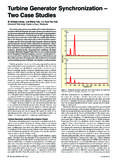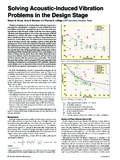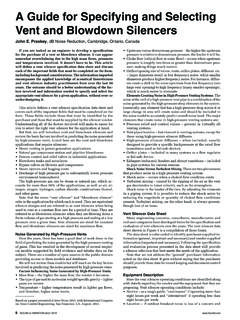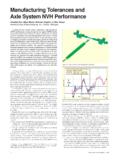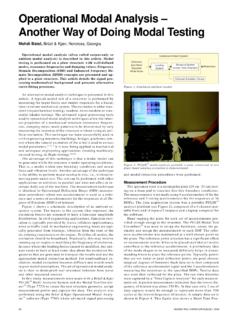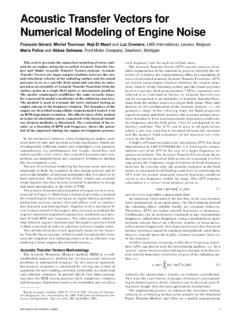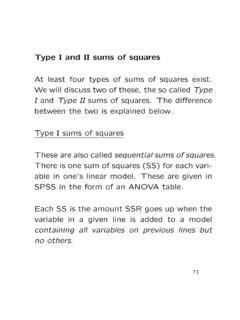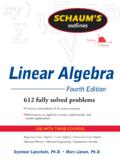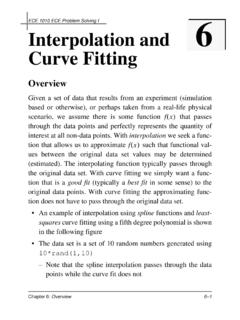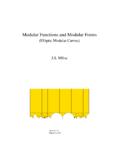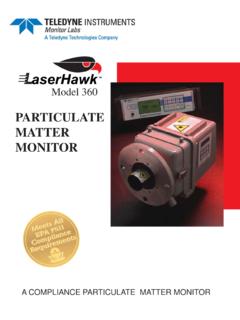Transcription of Bicycle Structural Dynamics - Sound and Vibration
1 Sound AND Vibration /JULY 2007 Bicycle Structural Dynamics Y. Champoux, S. Richard and Drouet, V lUS, Universit de Sherbrooke, Sherbrooke, Qu bec, CanadaThe joy of riding a Bicycle is enhanced with the advent of new materials, the development of new technologies and design procedures that improve comfort and durability. This article looks at the commitment of the research group V lUS to help the industry keep developing this incomparable machine by studying its dynamic Bicycle is a transport vehicle with unsurpassed efficiency and among the most used on the planet. Several million new bikes are sold each year, and this generates an important commercial activ-ity. As shown in Figure 1, a bike is a surprisingly simple structure made of a frame built from a few tubes assembled to create two triangles on which several components are attached.
2 This simple structure allows custom frame builders to make a living with an annual production of a few hundred bikes as well as allowing large companies to sell millions of bikes a year. Cost and marketing are obviously key factors in the business. On the technical side, the weight, stiffness and comfort of a bike are three important char-acteristics that still drive most new developments Steel, titanium and aluminum are materials still used in the industry but carbon fiber is becoming the most popular material for frames and for almost all bike Bicycle is a light structure that has to support a much heavier weight (the cyclist). The components and the frame are subjected to time-varying force excitations imposed by the cyclist and by the road. Its dynamic behavior becomes an important issue, because it is directly linked to the bike lifetime, maneuverability, efficiency and comfort.
3 Few studies have addressed the dynamic behavior of a bike in real operating conditions, and one reason is linked to rider influence. Not surprisingly, the coupling between a bike and a rider completely modifies the dynamic behavior of a bike. One has to simply consider that a bike exhibits lightly damped modes when tested in a free-free condition and highly damped modes when the bike is resting on a surface with the presence of a rider. The rider becomes part of the structure and introduces experimental difficulties and fuzziness to the at the Universit de Sherbrooke research group V -lUS have taken up the challenge in collaboration with the industry to develop know-how and knowledge in Bicycle Dynamics . The importance of teamwork, intellectual honesty and openness are essential ingredients in any relationship. The V lUS mechanical engineers, with expertise in modal analysis, metrology, material strength and biomechanics, joined their efforts to address these challenges.
4 Other objectives of V lUS are to characterize percep-tions, demystify wrong beliefs and to foster technology transfer to manufacturers. The mission of V lUS is to be recognized by researchers, people involved in the world of bicycling and by manufacturers to be an exceptional partner in knowledge develop-ment and in technology Analysis of Frames and ComponentsTo get a good idea of the dynamic behavior of a Bicycle structure, experimental modal analysis (EMA) can be used while considering different operating conditions in the lab with or without a cyclist or on the road. EMA allows input forces, natural frequencies, modal damping and scaled modal shapes to be obtained. SIMO (single input multiple output) and MIMO (multiple input multiple output) analyses were carried out using one or several shaker configura-tions.
5 For SIMO, a single shaker is connected to the front wheel axle imposing forces in-plane and out-of-plane directions. For the MIMO configuration, an additional shaker is installed on the handlebars as shown in Figure Setup. For a better understanding of how the presence of a cyclist influences a bike s dynamic behavior, tests were conducted with and without the cyclist and the bike rest-ing on a flat surface. Figure 2 shows the general arrangement of Figure 1. Bike frame and 2. Setup for SIMO and MIMO more manufacturers can learn and un-derstand about the dynamic response of their products, the more they will be able to benefit both current and potential MATERIALS REFERENCE ISSUE 17the experimental setup. The bike is resting on a steel table and is held vertically with a set of soft elastic bands. The stiffness of the bands is selected to adequately support a 160-lb rider resting statically on the bike.
6 In SIMO testing, only shaker 1 is used. This shaker is a 50 force-lb shaker from MB Dynamics . The excitation is located on the front axle, and the horizontal force is oriented with an angle of 30 relative to the plane of the bike (see Figure 3). Shaker 2 (Br el & Kj r, Type 4809) is installed on the handlebars to carry out the MIMO analysis, as shown in Figure 4. The handlebars proved to be a good location to input energy to the structure due to the damping caused by the presence of the rider s Random excitation (bandwidth 10-810 Hz) is used for both SIMO and MIMO analyses. A lower-limit frequency of 10 Hz is selected to avoid DC components in the force signal causing undesirable displacement of the bike. For testing with a cyclist on the bike, an instrumented stem is used to measure the force applied to the handlebars by the rider.
7 The rider is asked to keep a constant natural DC force ap-plied to the handle bar throughout the tests. This cyclist attitude control is essential to maximize the reproducibility and to make the system time response was measured using a PCB triaxial accel-erometer at 69 locations throughout the entire bike. This experi-mental setup also included measurements on both wheels at eight measurement points located on each tire rim. Shaker control and data acquisition are performed using Br el & Kj r PULSE system, and the modal parameters are extracted with Vibrant Technology ME scopeVES software using a polyno-mial curve-fitting Test Results Without Cyclist. Table 1 presents the results and a brief description for each mode of the SIMO test without a cyclist. Figure 5 shows three out the seven modes identified. The first mode is associated with the front and back movement of the front wheel, the fork horizontal stiffness being much lower than the stiffness of other parts of the bike.
8 Without a rider, the damping ratios of all measured modes are about 2%.Modal Test Results With Cyclist. Both SIMO and MIMO tests have been used for modal analysis when a cyclist is on the bike. The hands of the cyclist have a drastic effect on the bike s behavior due to energy transfer to the hands. A second shaker is then required to adequately disperse the excitation energy and to reduce nonlinear effects. The second reference provided by the additional shaker is also useful for identifying complex and local modes. Table 2 shows the modal parameters obtained in SIMO and MIMO configurations with a results of the tests with a cyclist show that both SIMO and MIMO analyses give similar results for natural frequencies and mode shapes. However, damping ratios vary according to the technique employed. Also, the MIMO technique can extract one more mode than SIMO analysis (Mode 3).
9 This can be explained by the fact that the there is a node of that mode at the reference location for the SIMO test (location of Shaker 1).A comparison of Tables 1 and 2 shows that, as expected, the biker has a strong influence on the Dynamics of a bike and almost all the modal parameters are modified. With a biker, there are only few Figure 3. Shaker 1 imposing horizontal force at 30 off bike 4. Shaker 2 mounted on 1. Modal parameters from the SIMO test without cyclist. Mode Frequency, Hz Damping, % Mode shape description 1 Vertical motion of bike (no deformation) Front-to-back motion of fork 2 Steering tube torsion 3 Front-to-back motion of fork 4 Frame first bending mode 5 Stem torsion mode 6 Stem bending mode 7 Front-to-back motion of handlebars Table 2.
10 Modal parameters from the SIMO and MIMO tests with cyclist. Frequency, Hz (Damping, %) Mode SIMO MIMO Description 1 ( ) ( ) Front-to-back motion of fork 2 ( ) ( ) Frame torsion, lateral motion of fork and front wheel first bending mode 3 ( ) Stem torsion and front wheel second bending mode 4 ( ) ( ) Lateral motion of fork and front wheel third bending mode 5 ( ) ( ) Lateral motion of the handle- bar tips and 3D fork motion 6 ( ) ( ) Fork and handlebars tips lateral motion and front wheel fourth bending mode 7 ( ) ( ) Lateral motion of fork and first bending mode for top tube and seat Sound AND Vibration /JULY 2007modes that can be extracted within the 10-100 Hz band. Most of the modes on the handlebars are not detectable. Only the first cantilever beam-like mode of the front fork and wheel is similar between the two configurations.

